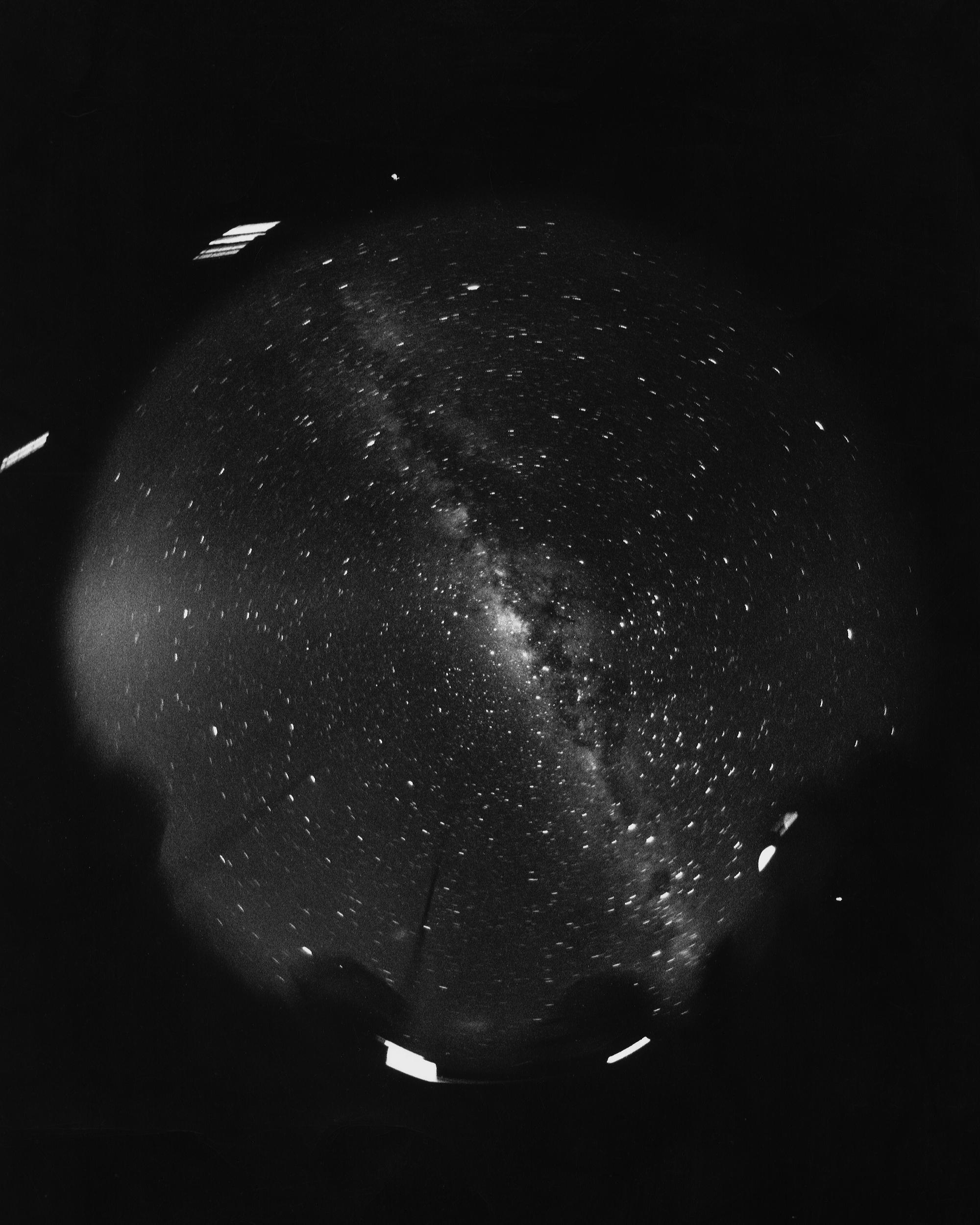 Night sky at CTIO.
Night sky at CTIO.
This image was taken with fish-eye lens by Dr Art Hoag in the 1970s (it is thought) at Cerro Tololo InterAmerican Observatory of NOAO The Milky Way is well in view. I think the distortion is caused by the fish-eye lens (used to get a wide field of view) since the center is on the Milky Way (I think), but the Milky doesn't run that close to the SCP.
Credit: A.Hoag/NOAO/AURA/NSF .
 Large Magellanic Cloud (LMC) in Dorado (Swordfish).
Large Magellanic Cloud (LMC) in Dorado (Swordfish).
The LMC and SMC (Small Magellanic Cloud) are dwarf irregular galaxies orbiting the Galaxy: they are both Irr I's (FK-585).
The LMC is at about 50 kpc from us, and so is within the Galaxy's dark matter halo. It was the closest known other galaxy until the Sagittarius dwarf elliptical was discovered in 1994 at about 27 kpc and the Canis Major Dwarf (elliptical) in 2003 at about 13 kpc from the Galaxy center (FK-592).
The bright pink region is the Tarantula Nebula which is a giant H II region.
Both LMC and SMC are unaided-eye objects in the southern Celestial Sphere hemisphere that have always been have always been known to southern observers.
In history, Al Sufi mentioned the LMC in 964 A.D., in his Book of Fixed Stars. The bright Canopes of Amerigo Vespucci are probably the Magellanic Clouds. Magellan on his circumnavigation circ 1519 finally brought them permanently into the historical record.
Credit: NOAO/AURA/NSF. See also the SEDS LMC page.
 M31: The Andromeda Galaxy.
M31: The Andromeda Galaxy.
M31 is a large spiral galaxy in the Local Group: it is the nearest large galaxy to the Milky Way and possibly a similar to the Milky Way.
M31 is visible to the unaided eye as a cloudy star. Remember, most of the stars seen in this image are foreground stars in the Milky Way.
M31 is about 725 kpc away (Cox-578). The disk diameter is about 20 kpc.
It is approaching us at 266 km/sec.
Credit: T.A.Rector and B.A.Wolpa /NOAO/AURA/NSF.
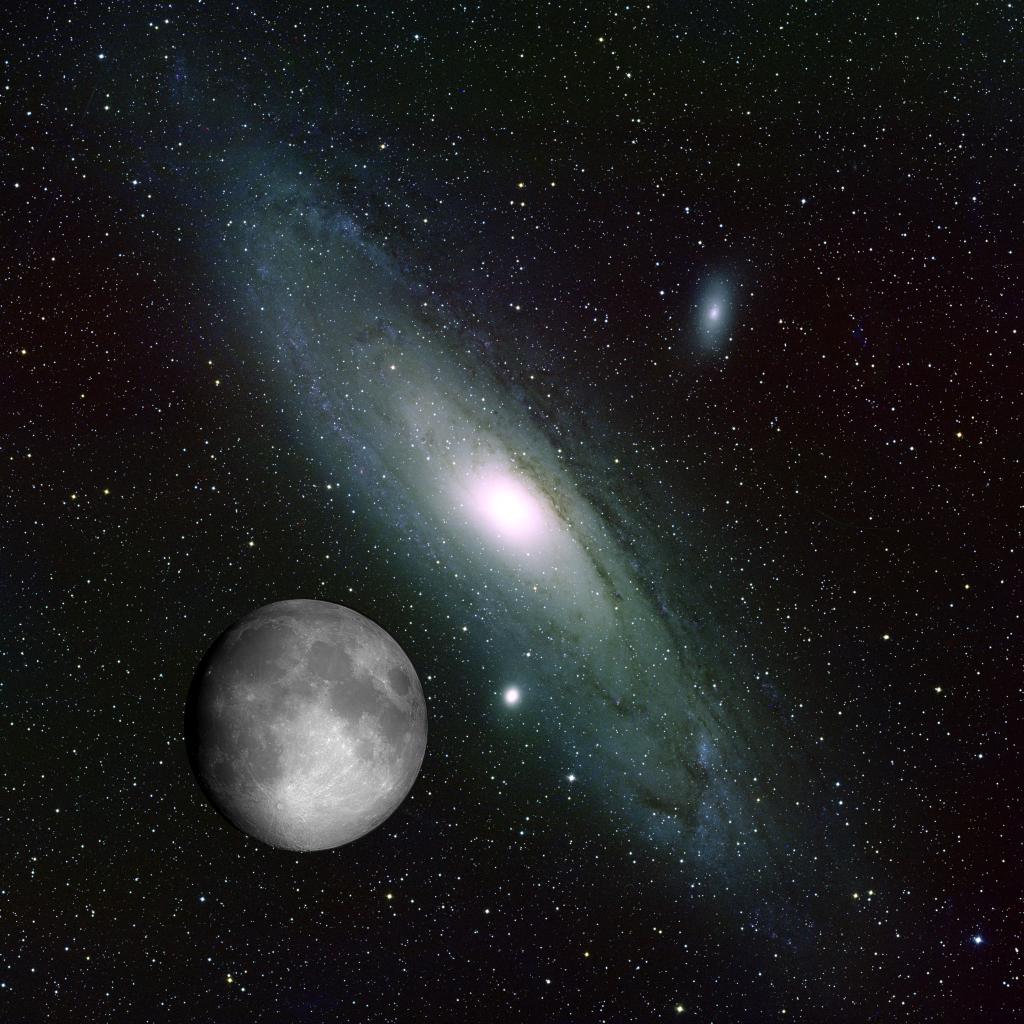 M31, NGC 224: The Andromeda Galaxy and Moon in collage.
M31, NGC 224: The Andromeda Galaxy and Moon in collage.
The objects are shown in their correct size on the sky. Of course, M31 because of it's low surface brightness never looks like this, except to 2-meter plus telescopes and/or longish exposure images. M31 just looks like a nebula in usual visual observation.
Also the Moon and M31 are never juxtaposed like this since M31 is not sufficiently near the ecliptic.
Recall the Moon's angular diameter is about 0.5 degrees. This sets the size scale for M31
M31 at about 900 kpc is the closest spiral galaxy: it is an Sb (Cox-578).
M31 was missed by Ptolemy (circa 100--175 CE) as a cloudy star in his 2nd centery CE catalog of 1022 stars in 1048 constellations: he labeled 6 or 7 stars as cloudy (No-113,402). It was recorded by Al-Sufi (903--986) in his Book of the Fixed Star (No-188,402), but Tycho Brahe (1544--1601) missed it his star catalog (No-299,308,402). Simon Mayr observed it telescopically in 1612 (No-402).
Credit: REU program, N.A.Sharp /NOAO/AURA/NSF.
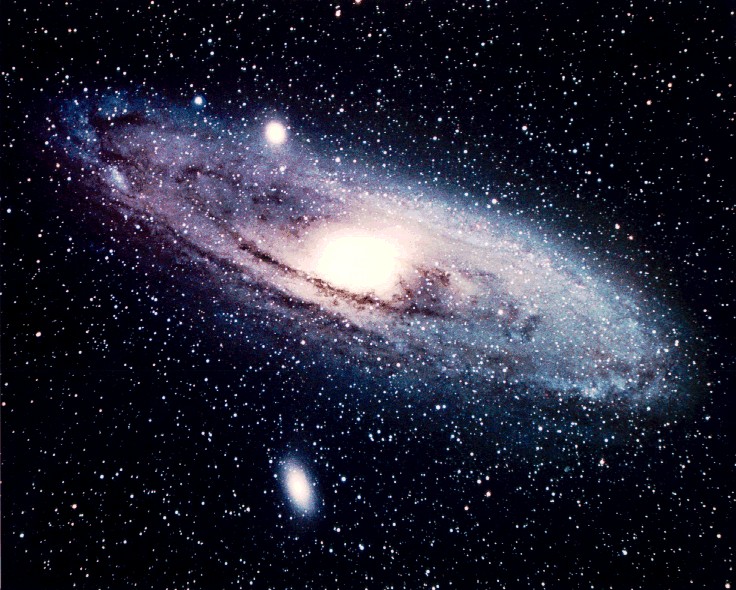 Another Andromeda Galaxy (M31) image.
Another Andromeda Galaxy (M31) image.
Credit: ????
 M33, NGC 958 (Sc) in Triangulum (i.e., the Triangulum Galaxy).
M33, NGC 958 (Sc) in Triangulum (i.e., the Triangulum Galaxy).
M33 is about 0.9 Mpc away and about 10 kpc across.
It is part of the Local Group of Galaxies. The Galaxy, the Andromeda Galaxy (M31), and M33 are the only spiral galaxies in the Local Group. M33 is relatively close to the Andromeda Galaxy (FK-593).
M33 is a flocculent spiral with fuzzy, poorly defined spiral arms thought to be formed by self-propagating star formation (CK-389).
The blue areas get there color from hot, massive, main sequence stars and the reddish areas are H II regions.
Credit: T.A.Rector (NRAO/AUI/NSF and NOAO/AURA/NSF) and M.Hanna (NOAO/AURA/NSF). For more information see the SEDS M33 page.
 M51, NGC 5194/5195 (Sc/SB?): The Whirlpool Galaxy in Canes Venatici.
M51, NGC 5194/5195 (Sc/SB?): The Whirlpool Galaxy in Canes Venatici.
M51 is actually two galaxies: NGC 5194, a large Sc spiral and a smaller companion NGC 5195 which a sort of barred galaxy.
M51 is about 8.5 Mpc away and 20 kpc across.
The spiral nature of some galaxies (historically nebulae) was first discovered from M51 by the 3rd Earl of Rosse (1800--1867; AKA William Parsons) in 1845apr at Birr Castle, Parsontown, Ireland using the Leviathan of Parsontown (1.83 m diameter telescope) (CK-366; No-435--437).
Credit: Todd Boroson/NOAO/AURA/NSF. For more information see the SEDS M51 page.
 A cartoon of the
Earl of Rosse's sketch of M51A/B,
NGC 5194/5195 (Sc/SB?): The Whirlpool Galaxy in Canes Venatici.
A cartoon of the
Earl of Rosse's sketch of M51A/B,
NGC 5194/5195 (Sc/SB?): The Whirlpool Galaxy in Canes Venatici.
M51 is actually two galaxies: NGC 5194, a large Sc spiral and a smaller companion NGC 5195 which a sort of barred galaxy.
M51 is about 8.5 Mpc away and 20 kpc across.
The spiral nature of some galaxies (historically nebulae) was first discovered from M51 by the 3rd Earl of Rosse (1800--1867; AKA William Parsons) in 1845apr at Birr Castle, Parsontown, Ireland using the Leviathan of Parsontown (1.83 m diameter telescope) (CK-366; No-435--437).
His Lordship circulated the sketch at the 1845jun meeting of the British Association for the Advancement of Science.
His Lordship did, in fact, believe that the spiral nebulae were other galaxies??? (No-437).
Credit: DJ Jeffery, WU 2005.
The sketch was made from the image of the original at the Sandburg Center for Sky Awareness where more of His Lordship's images can be viewed. It seems Cambridge University Press claims copyright on the images. Since they are just images of out-of-copyright original documents, this seems disputable to me. But I can't be bothered with others claims to owning copyright on historical images: I just make my own ``historical'' images as needed.
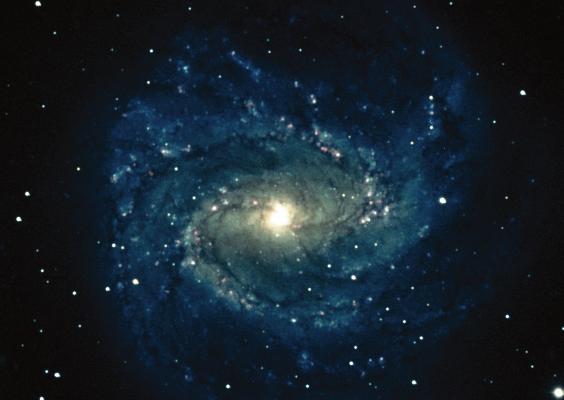 M83, NGC 5236 (SBc): The Southern Pinwheel Galaxy in Hydra.
M83, NGC 5236 (SBc): The Southern Pinwheel Galaxy in Hydra.
M83 is at about 5 Mpc.
Credit: Bill Schoening/NOAO/AURA/NSF . For more information see the SEDS M83 page.
 M87 (NGC 4486) in Virgo.
M87 (NGC 4486) in Virgo.
M87 is the giant elliptical galaxy at the center of the Virgo cluster, the nearest large cluster of galaxies at about 15 Mpc away (FK-593,615).
M87 is about 100 kpc in diameter and since it is rather spherical it has much more luminous mass than the Milky Way. It probably grew so large by galactic cannibalism.
M87 is surrounded by a rich system of globular clusters which are fairly clear in the image. (FK-615).
Credit: NOAO/AURA/NSF.
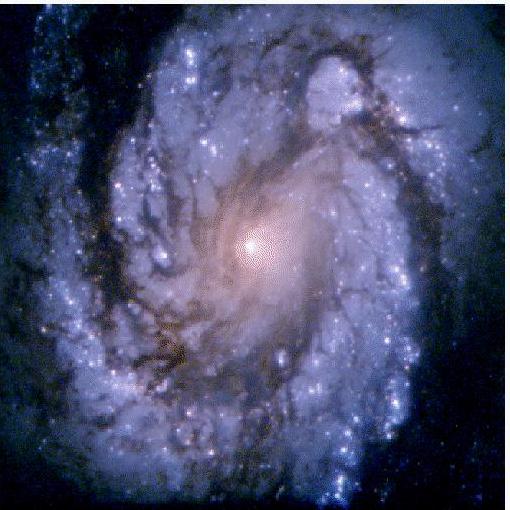 The core of galaxy M100 from HST, I guess.
The core of galaxy M100 from HST, I guess.
Credit: NASA/HST.
 M104, NGC 4594 (Sa): The Sombrero Galaxy in Virgo.
M104, NGC 4594 (Sa): The Sombrero Galaxy in Virgo.
The Sombrero Galaxy is Sa spiral galaxy seen nearly edge-on: it is tilted 6 degrees from its equatorial plane.
It is in the Virgo cluster at the southern edge.
It is about 9 Mpc from Earth and the disk is about 17 kpc in diameter.
The disk's angular diameter is about 6 arcminutes which is about 1/5 of the Moon's angular diameter
The large bulge is the giveaway for being an Sa galaxy even thought the arms are not easily discerned.
Note, the strong dust lane in the disk.
There is a swarm of about 2000 globular clusters in the halo. This about 13 times more than has the Milky Way. These globular clusters, like the Milky Way's, are calculated to be about 10--13 Gyr old.
It is hard to tell which of the star-like objects in the halo are foreground stars in the Milky Way and which are globular clusters: but we know some of them are globular clusters.
Credit: NASA and The Hubble Heritage Team (STScI/AURA). For more information see the SEDS M104 page.
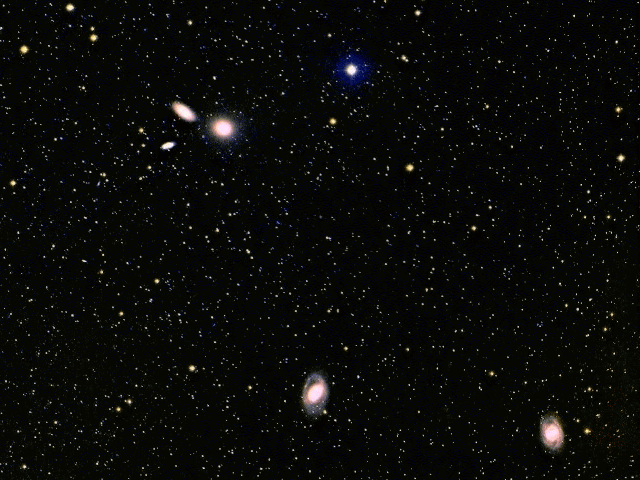 M96 Group or Leo I Group of Galaxies.
M96 Group or Leo I Group of Galaxies.
M96 (a spiral galaxy) is the brightest galaxy of this group. Probably the lower center spiral is M96.
Credit: ????
 HCG 87: Hickson Compact Group of Galaxies.
HCG 87: Hickson Compact Group of Galaxies.
The sources with points and many of the faint sources are foreground stars in the Milky Way.
The points are an artifact of the optical imaging system.
Credit: NASA/HST.
 Virgo cluster in Virgo. A part thereof.
Virgo cluster in Virgo. A part thereof.
The nearest rich cluster is the irregular Virgo cluster with more than 2000 galaxies. It's center is about 15 Mpc away and its overall size scale is about 3 Mpc and it covers an area of 10 X 12 degrees on the sky (FK-593).
To the lower left is M87, a giant elliptical, which is believed to be close to the dynamical center of the cluster. It is about 100 kpc in diameter (FK-615).
The image has cut-out rectangles a the upper left and lower right.
Credit: NOAO/AURA/NSF. For more information see the SEDS Virgo cluster page.
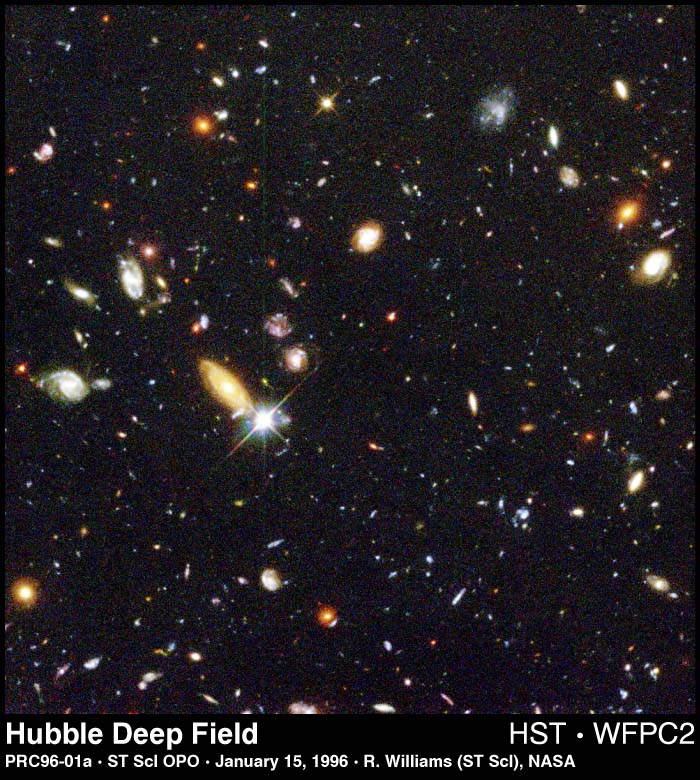 The Hubble Deep Field.
The Hubble Deep Field.
This is about 1/4 of the original HST deep field image (1995dec18--28): a random empty speck of sky: size here is about 1/60 of a degree: the whole deep field was 2.7 X 2.7 arcminutes.
It is true color (as much as possible) and the blue galaxies must be very blue to still be blue after high redshifts???. There are hundreds of galaxies visible: some the vary faintest are as they were probably only a billion years after the Big Bang. Most may be from 6--9 billion light years or 6--9 billion years in look-back time.
Credit: NASA/HST. This image is the public domain as it was
created by
and is not otherwise noted as copyrighted.
Download site:
Image:HubbleDeepField.800px.jpg.
This is ``a'' download site, but not where I originally got the
image which was who knows.
This map shows about 1.6 million galaxies in the nearby
universe detected at 2.2 microns in the near infrared.
The brightest galaxies are in blue and thus are mostly
nearby.
Faintest galaxies are in red, and thus are mostly relatively far away.
Green and yellow are somewhere in between, but the official caption
is not specific.
The color scheme thus gives representation of the 3-dimensional
large-scale structure.
The filaments, voids, and sudsy nature of the structure is suggested.
The untrained eye finds clusters, but
superclusters are harder to recognize.
There is a dark band that mostly lies on the edge of this image
with a spur at the top center.
This the band where Milky way disk of star and dust blocks our
view. The dark band is just an omission of sources.
Credit:
Atlas Image [or Atlas Image mosaic] obtained as part of the Two Micron
All Sky Survey (2MASS), a joint project of the University of Massachusetts
and the Infrared Processing and Analysis Center/California Institute of
Technology, funded by the National Aeronautics and Space
Administration and the National Science Foundation.
Particular Image Credit:
2MASS/T. H. Jarrett, J. Carpenter, & R. Hurt.
The image is released to the public domain.
3C273 was the first quasar to be recognized as such in 1963
by Maarten Schmidt at Caltech.
It's hydrogen
Balmer lines are redshifted by 15.8 % and its distance
is of order 600 Mpc
(FK-611).
3C273 is also a strong radio emitter
(FK-611).
The objects in the image are all points sources, except for
the jet protruding from 3C273.
The finite sizes are artifacts of the imaging process.
The jet presumable emerges from the
accretion
disk along its rotation axis.
The engine at the center of the
accretion
disk is a supermassive
black hole candidate.
Credit:
NOAO/AURA/NSF.
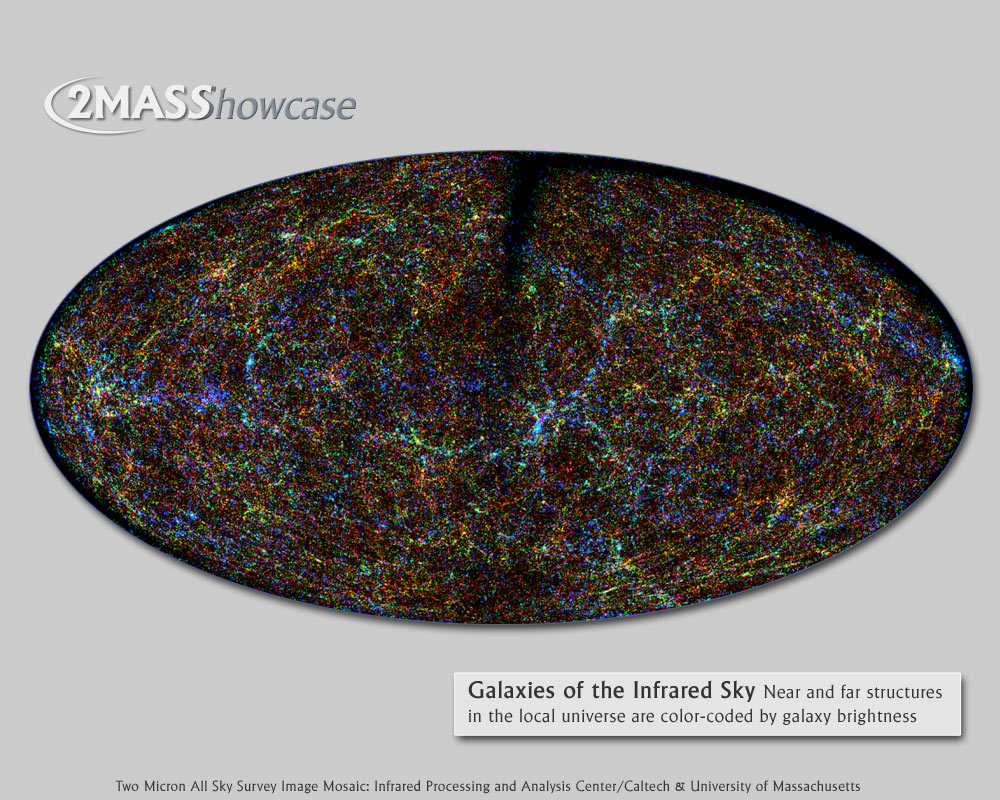 All sky galaxy map at 2.2 microns.
All sky galaxy map at 2.2 microns.
 Quasar 3C273 in Virgo.
Quasar 3C273 in Virgo.